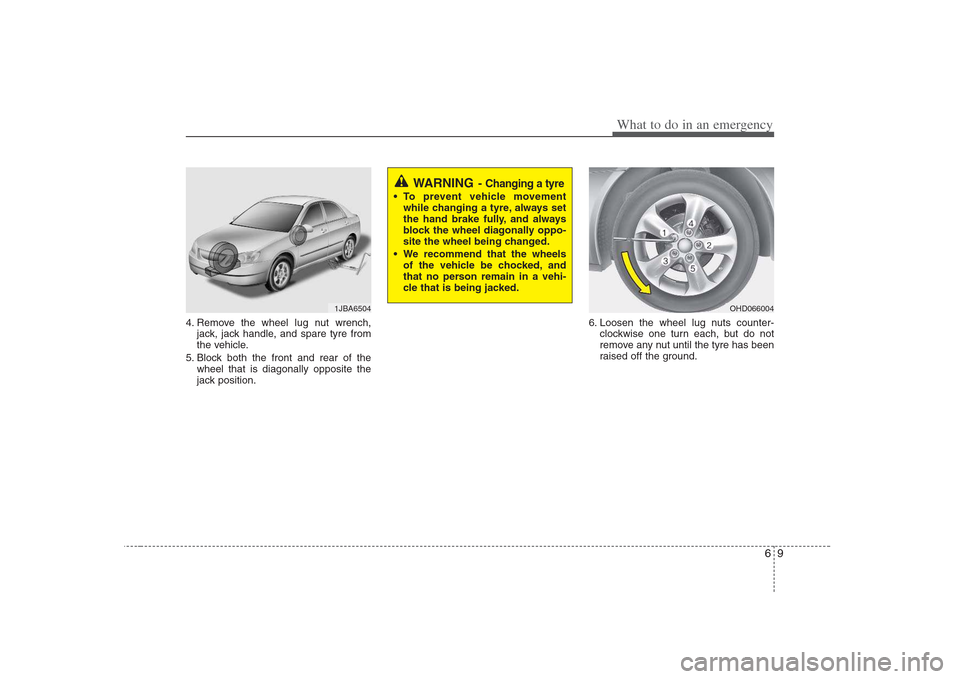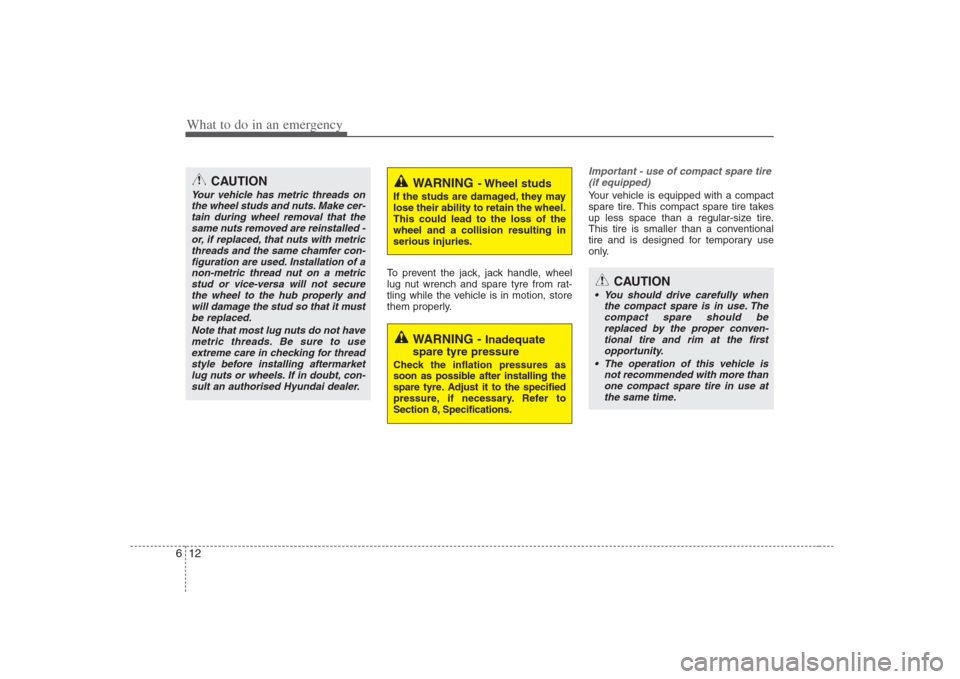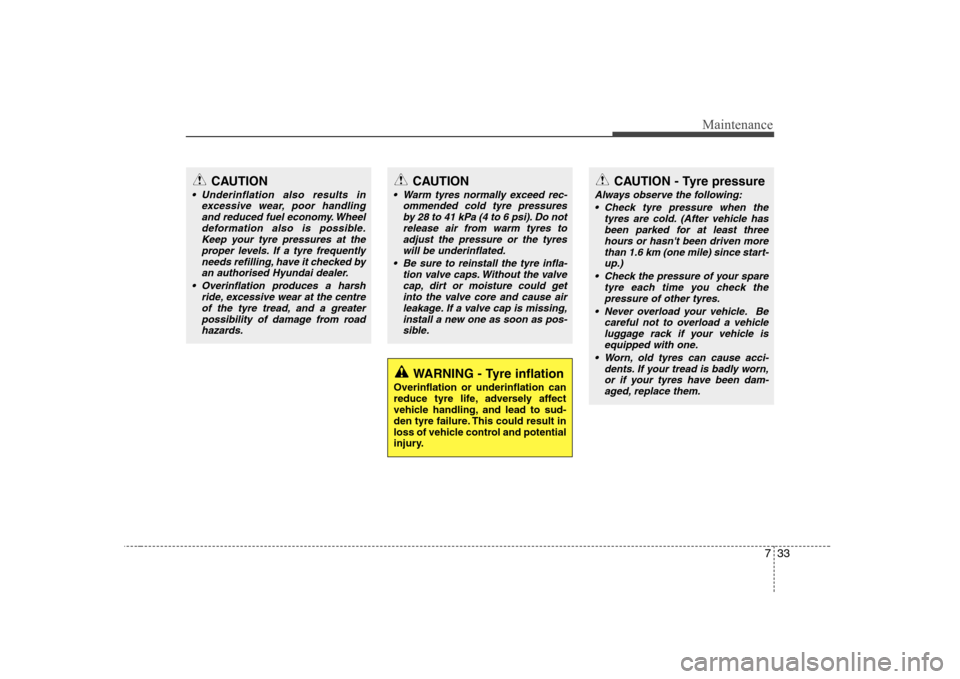2009 Hyundai Elantra spare wheel
[x] Cancel search: spare wheelPage 215 of 308

67
What to do in an emergency
IF YOU HAVE A FLAT TYRE
Jack and tools
The spare tyre, jack, jack handle, wheel
lug nut wrench are stored in the luggage
compartment. Remove the luggage
under tray out of the way to reach thisequipment.
1. Jack handle
2. Jack
3. Wheel lug nut wrench
4. Screwdriver
Jacking instructions
The jack is provided for emergency tyre
changing only.
To prevent the jack from “rattling” while
the vehicle is in motion, store it properly.
Follow jacking instructions to reduce the
possibility of personal injury.
OHD066002L
WARNING - Changing
tyres
Never attempt vehicle repairs in the traffic lanes of a public road
or highway.
Always move the vehicle com- pletely off the road and onto the
shoulder before trying to change
a tyre. The jack should be used
on level firm ground. If you can-
not find a firm, level place off the
road, call a towing service com-
pany for assistance.
Be sure to use the correct front and rear jacking positions on the
vehicle; never use the bumpers
or any other part of the vehicle
for jack support.
(Continued)
Page 217 of 308

69
What to do in an emergency
4. Remove the wheel lug nut wrench,jack, jack handle, and spare tyre from
the vehicle.
5. Block both the front and rear of the wheel that is diagonally opposite the
jack position. 6. Loosen the wheel lug nuts counter-
clockwise one turn each, but do not
remove any nut until the tyre has been
raised off the ground.
1JBA6504OHD066004
WARNING - Changing a tyre
To prevent vehicle movement
while changing a tyre, always set
the hand brake fully, and always
block the wheel diagonally oppo-
site the wheel being changed.
We recommend that the wheels of the vehicle be chocked, and
that no person remain in a vehi-
cle that is being jacked.
Page 218 of 308

What to do in an emergency
10
6
7. Place the jack at the front or rear jack-
ing position closest to the tyre you are
changing. Place the jack at the desig-
nated locations under the frame. The
jacking positions are plates welded to
the frame with two tabs and a raised
dot to index with the jack. 8. Insert the jack handle into the jack and
turn it clockwise, raising the vehicle
until the tyre just clears the ground.
This measurement is approximately 30
mm. Before removing the wheel lug
nuts, make sure the vehicle is stable
and that there is no chance for move-
ment or slippage. 9. Loosen the wheel nuts and remove
them with your fingers. Slide the wheel
off the studs and lay it flat so it cannot
roll away. To put the wheel on the hub,
pick up the spare tyre, line up theholes with the studs and slide the
wheel onto them. If this is difficult, tipthe wheel slightly and get the top holein the wheel lined up with the top stud.
Then jiggle the wheel back and forth
until the wheel can be slid over the
other studs.
WARNING - Jack location
To reduce the possibility of injury,
be sure to use only the jack provid-
ed with the vehicle and in the cor-
rect jack position; never use any
other part of the vehicle for jack
support.
1JB6025OUN046018
WARNING
Wheels and wheel covers may have
sharp edges. Handle them carefully
to avoid possible severe injury.
Before putting the wheel into place,be sure that there is nothing on the
hub or wheel (such as mud, tar,
gravel, etc.) that interferes with the
wheel from fitting solidly againstthe hub.
If there is, remove it. If there is not good contact on the mounting sur-face between the wheel and hub,
the wheel nuts could come loose
and cause the loss of a wheel. Loss
of a wheel may result in loss of con-
trol of the vehicle. This may cause
serious injury or death.
Page 220 of 308

What to do in an emergency
12
6
To prevent the jack, jack handle, wheel
lug nut wrench and spare tyre from rat-
tling while the vehicle is in motion, store
them properly.
Important - use of compact spare tire
(if equipped)
Your vehicle is equipped with a compact
spare tire. This compact spare tire takes
up less space than a regular-size tire.
This tire is smaller than a conventional
tire and is designed for temporary use
only.
CAUTION
Your vehicle has metric threads on
the wheel studs and nuts. Make cer-tain during wheel removal that the same nuts removed are reinstalled -
or, if replaced, that nuts with metricthreads and the same chamfer con-figuration are used. Installation of a non-metric thread nut on a metric
stud or vice-versa will not securethe wheel to the hub properly andwill damage the stud so that it must be replaced.
Note that most lug nuts do not havemetric threads. Be sure to useextreme care in checking for thread style before installing aftermarket
lug nuts or wheels. If in doubt, con-sult an authorised Hyundai dealer.WARNING - Wheel studs
If the studs are damaged, they may lose their ability to retain the wheel.This could lead to the loss of thewheel and a collision resulting inserious injuries.
WARNING - Inadequate
spare tyre pressure
Check the inflation pressures as
soon as possible after installing the
spare tyre. Adjust it to the specified
pressure, if necessary. Refer to
Section 8, Specifications.
CAUTION
You should drive carefully when the compact spare is in use. Thecompact spare should bereplaced by the proper conven-
tional tire and rim at the firstopportunity.
The operation of this vehicle is not recommended with more than
one compact spare tire in use atthe same time.
Page 221 of 308

613
What to do in an emergency
The compact spare should be inflated to
420 kPa (60 psi).
✽✽NOTICE
Check the inflation pressure after
installing the spare tire. Adjust it to the
specified pressure, as necessary.
When using a compact spare tire,
observe the following precautions:
Under no circumstances should you exceed 80 km/h (50 mph); a higher
speed could damage the tire.
Ensure that you drive slowly enough for the road conditions to avoid all haz-
ards. Any road hazard, such as a pot-
hole or debris, could seriously damage
the compact spare.
Any continuous road use of this tire could result in tire failure, loss of vehi-
cle control, and possible personal
injury.
Do not exceed the vehicle’s maximum load rating or the load-carrying capaci-
ty shown on the sidewall of the com-
pact spare tire.
Avoid driving over obstacles. The com- pact spare tire diameter is smaller than
the diameter of a conventional tire and
reduces the ground clearance approxi-mately 25 mm (1 inch), which could
result in damage to the vehicle.
Do not take this vehicle through an automatic car wash while the compactspare tire is installed.
Do not use tire chains on the compact spare tire. Because of the smaller size,
a tire chain will not fit properly. This
could damage the vehicle and result inloss of the chain. The compact spare tire should not be
installed on the front axle if the vehicle
must be driven in snow or on ice.
Do not use the compact spare tire on any other vehicle because this tire has
been designed especially for your vehi-
cle.
The compact spare tire’s tread life is shorter than a regular tire. Inspect your
compact spare tire regularly and
replace worn compact spare tires with
the same size and design, mounted onthe same wheel.
The temporary spare tire should not be used on any other wheels, nor should
standard tires, snow tires, wheel cov-
ers or trim rings be used with the tem-
porary spare wheel. If such use isattempted, damage to these items or
other car components may occur.
Do not use more than one temporary spare tire at a time.
Do not tow a trailer while the temporary spare tire is installed.
WARNING
This spare tire should be used only
for VERY short distances. Compact
spares should NEVER be used for
long drives or extended distances.
Page 230 of 308

75
Maintenance
At least monthly:
Check coolant level in the coolantrecovery reservoir.
Check the operation of all exterior lights, including the stoplights, turn sig-
nals and hazard warning flashers.
Check the inflation pressures of all tyres including the spare.
At least twice a year
(i.e., every Spring and Fall) :
Check radiator, heater and air condi- tioning hoses for leaks or damage.
Check windshield washer spray and wiper operation. Clean wiper blades
with clean cloth dampened with wash-er fluid.
Check headlight alignment.
Check muffler, exhaust pipes, shields and clamps.
Check the lap/shoulder belts for wear and function.
Check for worn tyres and loose wheel lug nuts.
At least once a year :
Clean body and door drain holes.
Lubricate door hinges and checks, and
bonnet hinges.
Lubricate door and bonnet locks and latches.
Lubricate door rubber weatherstrips.
Check the air conditioning system before the warm weather season.
Inspect and lubricate automatic transaxle linkage and controls.
Clean battery and terminals.
Check the brake (and clutch) fluid level.
Page 257 of 308

Maintenance
32
7
TYRES AND WHEELS
Tyre care
For proper maintenance, safety, and
maximum fuel economy, you must
always maintain recommended tyre infla-
tion pressures and stay within the load
limits and weight distribution recom-
mended for your vehicle. Recommended cold tyre inflation pressures All tyre pressures (including the spare)
should be checked every day when the
tyres are cold. “Cold Tyres” means the
vehicle has not been driven for at least
three hours or driven less than 1.6 km(one mile).
Recommended pressures must be main-
tained for the best ride, top vehicle han-
dling, and minimum tyre wear. All specifications (sizes and pressures)
can be found on a label attached to the
vehicle.
WARNING - Tyre underin-
flation
Severe underinflation (70 kPa (10
psi) or more) can lead to severe
heat build-up, causing blowouts,tread separation and other tyre fail-ures that can result in the loss of
vehicle control leading to severe
injury or death. This risk is much
higher on hot days and when driv-
ing for protracted periods at highspeeds.
OHD086003R
Page 258 of 308

733
Maintenance
WARNING - Tyre inflation
Overinflation or underinflation can
reduce tyre life, adversely affect
vehicle handling, and lead to sud-
den tyre failure. This could result in
loss of vehicle control and potential
injury.
CAUTION - Tyre pressure
Always observe the following:
Check tyre pressure when the tyres are cold. (After vehicle hasbeen parked for at least threehours or hasn't been driven more
than 1.6 km (one mile) since start- up.)
Check the pressure of your spare tyre each time you check thepressure of other tyres.
Never overload your vehicle. Be careful not to overload a vehicleluggage rack if your vehicle is equipped with one.
Worn, old tyres can cause acci- dents. If your tread is badly worn,or if your tyres have been dam- aged, replace them.
CAUTION
Underinflation also results in
excessive wear, poor handlingand reduced fuel economy. Wheeldeformation also is possible.
Keep your tyre pressures at theproper levels. If a tyre frequentlyneeds refilling, have it checked byan authorised Hyundai dealer.
Overinflation produces a harsh ride, excessive wear at the centreof the tyre tread, and a greaterpossibility of damage from road
hazards.
CAUTION
Warm tyres normally exceed rec- ommended cold tyre pressuresby 28 to 41 kPa (4 to 6 psi). Do notrelease air from warm tyres to
adjust the pressure or the tyres will be underinflated.
Be sure to reinstall the tyre infla- tion valve caps. Without the valvecap, dirt or moisture could get
into the valve core and cause air leakage. If a valve cap is missing,install a new one as soon as pos-
sible.